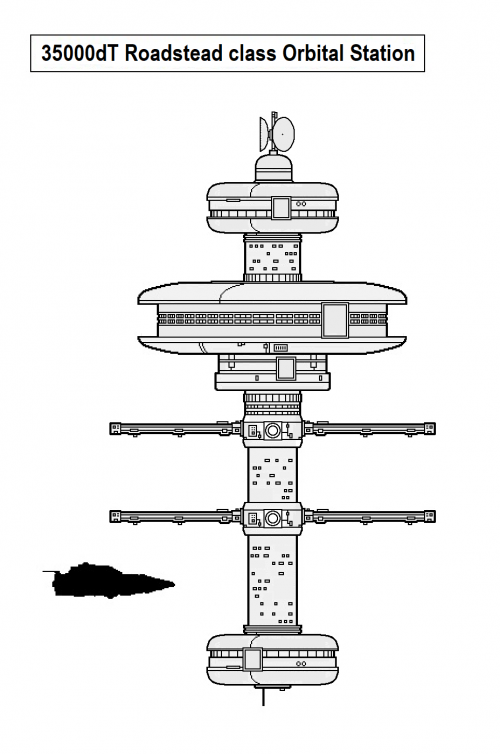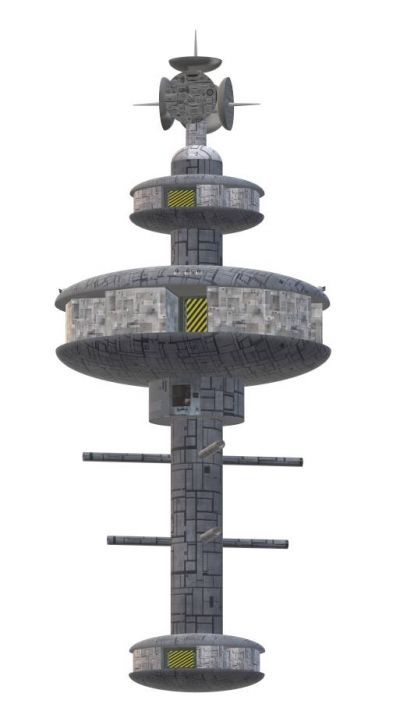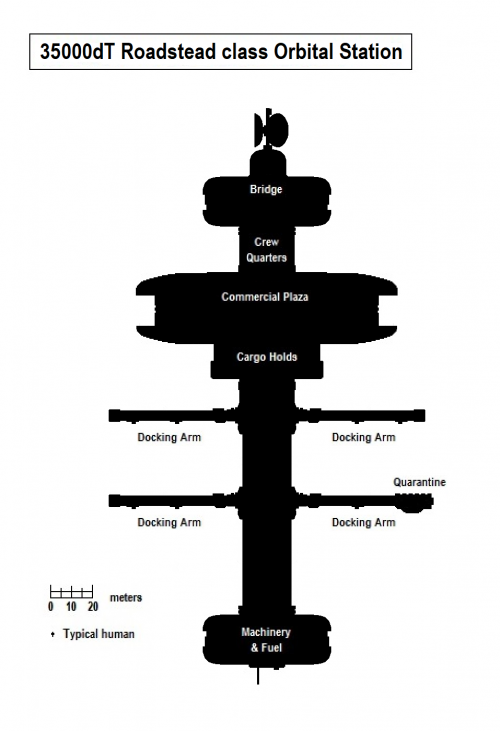Roadstead class Orbital Station
| Roadstead class Orbital Station | |
|---|---|
 Distant Fringe object. | |
| Type: AW Orbital Station | |
| Category | BCS |
| Size | 35,000 Tons |
| Hull Configuration | Close Structure Hull |
| Streamlining | Partially Streamlined Hull |
| Tech Level | TL–10 |
| Engineering | |
| Computer | Model/4 |
| Jump | J-0 |
| Maneuver | 0.5 G |
| Armaments | |
| Hardpoints | 350 |
| Accommodations | |
| Staterooms | 3,300 |
| Low Berths | 200 |
| Personnel | |
| Crew | 379 |
| Officers | 76 |
| Enlisted | 303 |
| High/Mid Passengers | 1,600 |
| Low Passengers | 200 |
| Payload | |
| Cargo | 10,200 Tons |
| Fuel tank | 3,000 Tons |
| Special features | 3,500t hangar space |
| Construction | |
| Construction Time | 44 Months |
| Origin | Distant Fringe |
| Price | |
| Cost | MCr13,200 |
| Statistics | |
| Universal Ship Profile | WO–M40X142–090000–80008-0 |
| Images | |
| Blueprint | No |
| Illustration | Yes |
| Source | |
| Canon | Unpublished, fan design |
| Designer | Ade Stewart |
| Design System | High Guard |
| Era | 1105 |
| Reference | Fan: Ade Stewart |
The Roadstead class Orbital Station is a TL–10 large Orbital Station.
- Please also see AAB article: Ships of the Distant Fringe.
Description (Specifications)[edit]
The Orbital Station is a large commercial orbital facility found within systems in the Distant Fringe region. It is classified as an Orbital Complex. Similar designs have been in use from the time the Distant Fringe was first settled.
Image Repository[edit]
- A Roadstead class Orbital Station with a Wulf class Free Trader (silhouetted) alongside.

- Approaching a Roadstead class Orbital Station

General Description & Deck Plans[edit]
- A basic plan of the station indicating the general layout and positioning of major elements.

The station is constructed as a close structure. It has four major elements - a cylindrical upper habitat, a central column, a large cylindrical primary habitat, and a cylindrical lower habitat. Eight commercial berthing arms project from the central column.
The central column has an overall height of 237 meters and a mean diameter diameter of 22 meters, and contains 75 decks of varying heights. The primary habitat has a diameter of 105 meters, a height of 35 meters and has 11 decks. Both the upper habitat and the lower habitat have diameters of 60 meters, heights of 25 meters, and each contains 8 decks. Each of the eight docking arms has a length of around 60 meters: one terminates in isolation and quarantine facilities. Some sections of the station are narrower and some are wider, giving it a total enclosed volume of approximately 472,500 cubic meters.
The main fuel tanks and the heavy machinery are located within the lower habitat. The main control center is located on the upper decks of the upper habitat and a secondary secondary control room is located close to the base of the central column, above engineering. The main cargo decks are located directly below the primary habitat and include the cryogenic (low berth) sections. General crew quarters are located within the upper part of the central column, though Stewards have rooms close to passenger accommodations and senior crew have accommodations close to the control centers. Second class accommodations are found within the less desirable central column while first class cabins occupy the outer part of the primary habitat, with windows offering spectacular views. The main commercial and leisure facilities lie at the core of the primary habitat and are focused on a multi-deck open plaza.
Basic Ship Characteristics[edit]
Following the Imperial Navy and IISS Universal Ship Profile and data, additional information is presented in the format shown here. The small craft factor indicates the number of squadrons (...of ten subcraft) carried on the ship. Tonnage on the universal ship profile is shown in kilotons (...thousands of tons) where necessary. [1]
| Basic Ship Characteristics [2] | ||
|---|---|---|
| No. | Category | Remarks |
| 1. | Tonnage / Hull | The Orbital Station is constructed using a 35,000 dTon hull built in a close structure configuration. The hull is unstreamlined and cannot survive entry into a planetary atmosphere.
|
| 2. | Crew | Total Crew Complement: 379
Accommodations:
There are x200 Low Berths. The low berths are overseen by the station's medical staff, assisted by properly trained service crew. These are most commonly used to store livestock but they may also be utilized by individuals wishing to wait out a period of time (most commonly for financial or tax reasons), or by those seeking medical procedures that may not be locally available or may require the arrival of a specialist. It is rare that the station's low berths are fully occupied. Accessible areas of the hull are fitted with grav plates and inertial compensators and have full life support and environmental systems.
|
| 3. | Performance | The station mounts a Maneuver half-drive, and a Power Plant-1, giving performance of 0.5-G acceleration (sufficient for orbital positioning only) and producing 450 Energy Points. The station does not have an agility rating. The dedicated internal fuel tankage gives the power plant 4 weeks duration.
|
| 4. | Electronics | Adjacent to the bridge is a Model/4 Computer: the station has x2 backup Model/4 Computers.
|
| 5. | Hardpoints | x350 hardpoints.
|
| 6. | Armament | x5 100-Ton bays, mounting Heavy Missile Launchers.
x100 triple Beam Laser turrets, grouped into ten batteries of 10 linked turrets. |
| 7. | Defenses | The hull is plated, braced and structurally reinforced, with an armor rating of 4.
x200 triple Sandcaster turrets, typically grouped into twenty batteries of 10 linked turrets. The station is not fitted with screens or other passive defensive systems. |
| 8. | Craft | The station is not supplied with intrinsic subcraft: these are purchased as required by the station's operators.
Hangars |
| 9. | Fuel Treatment | The station has internal fuel tankage of 3,000 dTons.
|
| 10. | Cost | The basic cost of the station is MCr13,200.000
|
| 11. | Construction Time | 176 weeks (44 months) as standard.
|
| 12. | Comments | Standard cargo capacity amounts to 10,200 dTons.
|
History & Background (Dossier)[edit]
Roadstead class Orbital Stations are rugged and known for their excellent safety record. Many are finished to very high standards, offering services and facilities equivalent to surface hotels, leisure complexes and shopping malls, but with the additional benefit that they are free of any local taxes and surcharges. The design is representative and a large number of variants exist, particularly with regard to the allotted weapons systems, onboard electronics, and the fit out of internal spaces.
Support Craft[edit]
The station relies on a variety of support craft.
Interface Craft:
- Colossus class Heavy Lander (typically operating from the commercial arm).
- Deliverance class Lifeboat (often secured to the exterior of the hull and accessed by airlocks).
- Excellence class Fast Shuttle (typically operating from internal hangars).
Tankers:
Class Naming Practice/s & Peculiarities[edit]
A number of companies manufacture facilities equivalent to the Roadstead class Station.
They vary in hull shape and internal layout but all share the same basic design and all have very similar capabilities and performance characteristics
Selected Variant Types & Classes[edit]
3 Representative Station (AW) Classes[edit]
References[edit]
| This article has metadata. |

|
This ship was originally designed using one of the Classic Traveller ship design rules:
|
- Author & Contributor: Lord (Marquis) and Master Scout Emeritus Adie Alegoric Stewart of the IISS
- ↑ Timothy B. Brown. Fighting Ships (Game Designers Workshop, 1981), 10.
- ↑ Timothy B. Brown. Fighting Ships (Game Designers Workshop, 1981), 10.